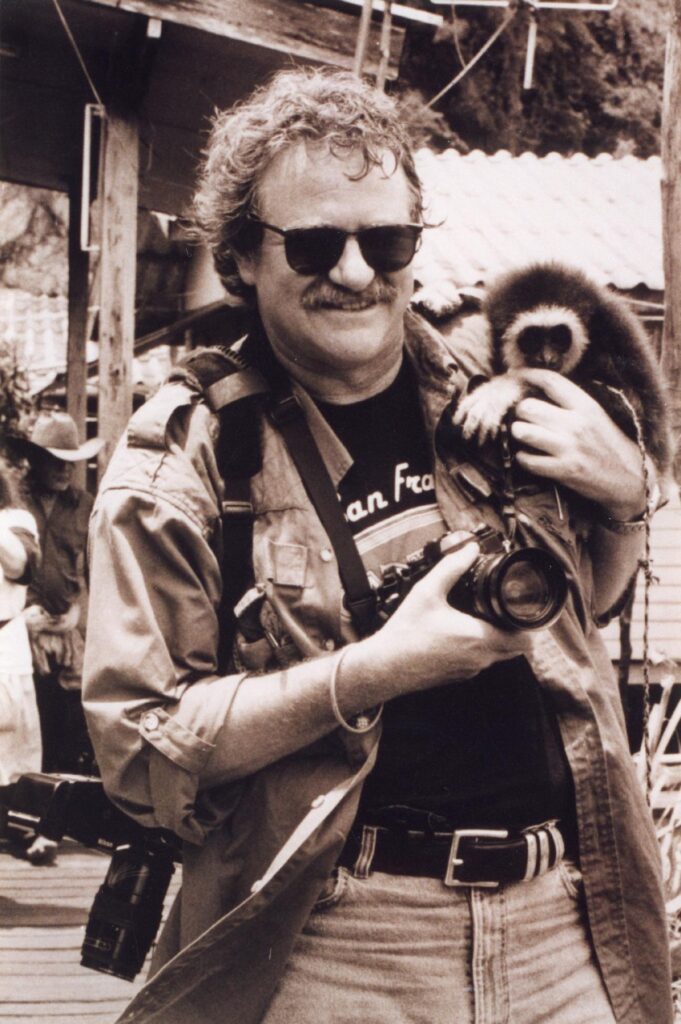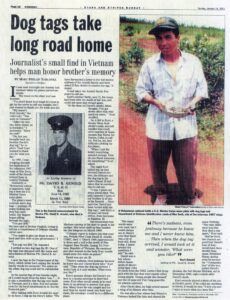(Photo of Marc Yablonka on Panyi Island, Gulf of Thailand in 1996 by James Caccavo)
DOG TAGS TAKE THE LONG ROAD HOME
(from Stars and Stripes Sunday, January 14th, 2001)
(Photo of Marc Yablonka on Panyi Island, Gulf of Thailand in 1996 by James Caccavo)
By Marc Phillip Yablonka
Special to Stripes
In a poignant story of remembrance and connection, the journey of reconnecting a fallen Marine’s dog tag unfolds.
A Late-Night Call
It was near midnight one Sunday last summer when the phone jarred me awake. The voice on the other end was hesitant.
“You don’t know how tough it’s been to get up the nerve to call you tonight, but I just wanted to thank you for what you did.
“My name’s Kurt Arnold,” the voice said. “You were in Vietnam?”
“After the war, yes, three times, as a journalist,” I answered. “Have we met?”
“No, but you brought back my brother David’s dog tag,” he replied. “And I just wanted to thank you for what you did.”
The Journey to Khe Sanh
In 1995, I was trudging through the battlefield of the infamous 1968 siege at Khe Sanh, south of the Demilitarized Zone in central Vietnam. Suddenly a Vietnamese national appeared, holding a bent tin US Marine Corps mess plate. The plate’s main contents were dog tags—perhaps 20, many looking like they had seen battle. My fingers began sifting through the tags.
“You pay 30 dollar,” the man said in broken English, trying to sell me a Department of Defense ID card.
“You ought to give me these to take back and turn over to my government,” I said. I settled on two dog tags for $2. One of the tags was stamped with the name and information of Marine Pfc. David B. Arnold. I sent the tags to the Department of the Navy, which wrote back, saying that the Arnold family would be contacted. The name on the other tag could not be substantiated.
In the mental fog of that Sunday night, all I could recall was, “…It is also a possibility that the tag was made in Vietnam, and is a fake. It is not uncommon for the local inhabitants to do this for financial gain.”
The Long Wait
After talking with Kurt for nearly an hour, I dug up the Navy’s letter. “We have forwarded a letter to the last known address of the Arnold family and have asked if they desire to receive the tag,” it stated. It had taken the Arnold family five years to call me.
Kurt’s mother, Betty, now 71, for years had lived with the death of her son and could not open that wound again.
“At the time [of David’s death], Mom thought, ‘I’ve got seven other kids who need me more,’” Kurt recalled. So, it fell to Kurt, a former Navy boatswain’s mate, aircraft handler, and crash crew member at Guantanamo Bay Naval Air Station, Cuba, to call me. But he, too, had difficulty picking up the phone.
“When I got the letter, everything seemed strange. How do you thank someone for something?” Kurt asked.
Memories of David
The night before Kurt called me, he had showed David’s letters, his obituary, and the dog tag to his wife’s friend. It had taken that to convince him to call me.
“I was three years old when David died. The only memory I have of my brother is of him at the funeral…Mom said that David had been buried with his dog tags,” said Kurt, a 34-year-old truck driver from his home in Palatine, Ill.
He remembers two Marines coming to the door to speak to his mother. Her heart sank as they handed her the telegram in March 1969:
“I deeply regret to inform you that your son, Private First-Class David B. Arnold, USMC, died 11 March 1969, approximately three and a half miles north of Fire Support Base Neville, Quang Tri Province, Republic of Vietnam. He sustained gunshot wounds to the body from hostile small arms fire on patrol.”
David was not yet 20.
“There’s sadness, even jealousy because he knew me and I never knew him,” Kurt said. “Then, when the dog tag arrived, I would look at it and wonder, ‘What were you like?’”
Kurt’s parents always hid David’s letters in a manila envelope in their bedroom. Kurt would often sneak in to read them in an attempt to answer that question. Many times, he was caught, and the next time he would sneak into the bedroom, the envelope would be in a different place.
“Not many words were ever said, but I could always see in Mom’s eyes that there was a lot of hurt still. Even today, I tiptoe around the questions I ask,” he said.
A Legacy Remembered
David was a boy whose letter home spoke of discovering tiger cubs 10 yards from the DMZ. Letters that struggled with the fact that wars mainly affect young people. Young people like himself and the 15-year-old Viet Cong guerrilla his platoon captured.
After David died, his high school named a wing of its library after him. He was also a boy whose best friend in Vietnam looked like him and shared the same birthday. “The only difference was that they died a day apart,” Kurt said.
Had he lived, the chances are good that David’s tour of duty would have been shorter than usual. President Nixon, during what he termed the “Vietnamization” of the war, pulled David’s division, the 3rd Marine Division, out in November 1969, eight months after David’s death.
Kurt recently placed a photo of his son at David’s grave. If he could say anything to David, it would be this: “I love you and I want to know what you were like.”
Addendum
Around 2008, I sent the second dog tag to the Joint POW/MIA Accounting Command, which was able to locate the family of the Marine whose dog tag I had also brought home from Vietnam in 1995. They sent the dog tag to the deceased Marine’s family, but, for whatever reason, the family declined to accept it. Then, during a subsequent trip I took to Washington, D.C. in 2010, I found that Marine’s name in the docent’s book of names at the Vietnam Memorial and placed the dog tag at the foot of the panel upon which his name is inscribed.
For more on the Vietnam War and its lasting effects, visit The Vietnam Veterans Memorial Fund. To learn about the efforts to recover and identify missing service members, check out the Defense POW/MIA Accounting Agency. Be sure to check out our blogs for Striper highlights at NSSML Blog.


